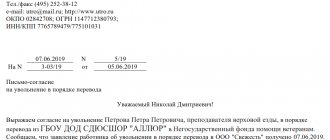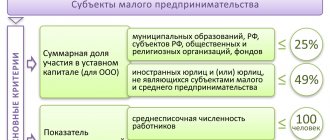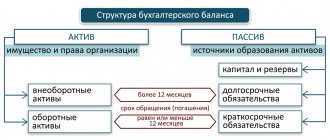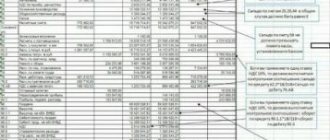In 2022, non-exclusive rights of use for results of intellectual activity (RIA) - rights of use for RIA in accordance with license agreements or other documents confirming the existence of the right to RIA, including non-exclusive licenses for software products, are taken into account in accordance with the provisions of the federal standard “Intangible assets”, approved by order of the Ministry of Finance of the Russian Federation dated November 15, 2019 No. 181n.
- How intangible assets are taken into account in 2022
- The procedure for transferring non-exclusive rights of use to RIA to the balance sheet
- How to register in 1C
How intangible assets are taken into account in 2022
In accordance with Instruction 157n in the Unified Chart of Accounts, rights in accordance with license agreements or other documents confirming the existence of the right to such an asset are recorded in the corresponding analytical accounting accounts. 111.60
“Rights to use intangible assets”:
- on account 111.6N
“Rights to use scientific research (research developments)” - rights to use the results of scientific research (research developments); - on account 111.6R
“Rights to use experimental design and technological developments” - rights to use the results of experimental design and technological work; - on account 111.6I
“Rights to use software and databases” - rights to use software and databases; - on account 111.6D
“Rights to use other objects of intellectual property” - rights to use other intangible assets.
In order to reflect the rights to use intangible assets (non-exclusive rights to RIA), the following sub-articles of KOSGU are applied:
- for non-exclusive rights with a certain useful life 352 and 452 KOSGU;
- for non-exclusive rights with an indefinite useful life in accordance with clauses 11.5.3 and 12.5.3 of Order No. 209n: 353 and 453 of KOSGU.
Let us note that cash expenses for the acquisition of non-exclusive rights to use RIA, as before, are subject to reflection under subarticle 226 “Other work, services” of KOSGU (clause 10.2.6 of Procedure No. 209n).
How to take into account the costs of an electronic digital signature key in tax accounting
Question: In April 2022, an organization discovered an error when calculating income tax for 2022. Namely: when receiving a public key for verifying an electronic digital signature (EDS key) in November 2022 for a year, its cost was not fully taken into account as part of tax costs. The organization wrote off the cost of the EDS key monthly in the amount of 1/12. How can I correct my 2022 return in this case?
Answer: If it is discovered in April 2022 that the full cost of the digital signature key received in November 2022 was not taken into account when calculating income tax, an updated declaration for 2022 is submitted. Section I of Part I of the declaration is filled out on a cumulative basis, taking into account the changes made. The amount of tax to be reduced is indicated in Section III of Part I.
Rationale: The costs of registering and obtaining an electronic digital signature key are expenses for the current activities of the organization and relate to management. And since they cannot be correlated with the income that the organization plans to receive in a certain period, such expenses are reflected in the accounting accounts and are taken into account as part of tax expenses in the period in which they are incurred. In our case, the organization had to take into account the entire cost of the digital signature key in November 2022. It does not matter that the established validity period of the key is 1 year <*>.
Let's look at how to make corrections to the income tax return (hereinafter referred to as the return) for the last tax period - the calendar year. Income tax is calculated on an accrual basis from the beginning of the year. Therefore, in the situation under consideration, the organization needs to submit an updated declaration for 2022 to the tax authority <*>.
The updated declaration is submitted in the form in force in 2017. On the title page of such a declaration, a note indicating the introduction of changes and (or) additions (sign “X”) <*> is made.
The indicators of Section I of Part I are filled in with cumulative totals for 2017, taking into account any changes and (or) additions made. In particular, line 2 of Section I of Part I shows the full cost of the received EDS key <*>.
Section II of Part I of the declaration is not completed. The amount of income tax subject to additional payment (reduction) in connection with a detected error is indicated in Section III of Part I. In the situation under consideration, in the line “IV quarter” of Section III of Part I, the organization indicates the amount of income tax to be reduced in connection with the corrections made < *>.
The procedure for transferring non-exclusive rights of use to RIA to the balance sheet
One example of objects recorded on account 111.60 “Rights to use intangible assets”, namely on account 111.6I “Rights to use software and databases”, are software products used in the activities of the institution on the 1C: Enterprise platform.
The delivery package for a program, for example “1C: Public Institution Accounting 8,” includes a license agreement under which the licensee is granted separate non-exclusive rights to use the program.
The license agreement for the 1C program is unlimited and is a document confirming that the licensee has the rights granted by the copyright holder to use the software product.
A document confirming that the licensee has the right to use the program on several workstations is an additional client license (licenses) for a certain number of workstations.
Until 01/01/2021, according to Instruction No. 157n, non-exclusive rights to use the results of intellectual activity, including licenses for non-exclusive rights to use software products, were recorded in off-balance sheet account 01 “Property received for use”. Account 401.50 “Deferred expenses” took into account expenses associated with the acquisition of a non-exclusive right to use intangible assets over several reporting periods.
From January 1, 2022, in accordance with the order of the Ministry of Finance of the Russian Federation dated September 14, 2020 No. 198n, such objects recorded on the balance sheet in account 01 must be taken into account on the balance sheet as part of account 111.6I “Rights to use software and databases.”
Methodological recommendations for the application of the Standard “Intangible Assets” are communicated by letter of the Ministry of Finance of the Russian Federation dated November 30, 2020 No. 02-07-07/104384.
These guidelines contain provisions for the first application of the Standard and transitional provisions. In contrast to the transitional provisions of previously implemented standards (Order of the Ministry of Finance of the Russian Federation dated February 28, 2018 No. 34n, Order of the Ministry of Finance of the Russian Federation dated December 7, 2018 No. 256n, Order of the Ministry of Finance of the Russian Federation dated December 31, 2016 No. 257n, etc.), according to which the acceptance of objects for balance sheet accounting , meeting the criteria of an asset, was reflected during the inter-reporting period in correspondence with account 401.30 “Financial result of previous reporting periods”, the transfer from off-balance sheet accounting to balance sheet accounting of the rights to use intangible assets is carried out in 2022 operations in the following order:
“Recognition of accounting items that were not previously recognized as part of intangible assets and (or) reflected in off-balance sheet accounting as part of the group of non-financial assets in accordance with the GHS “Intangible Assets” is carried out by operations in 2021 based on the results of an inventory, which is carried out in order to identify such accounting items accounting.
Expenses for the acquisition of non-exclusive rights, previously recorded in account 401.50 “Deferred expenses”, the useful life of which as of January 1, 2022 is less than 12 months, are charged to the financial result on the first working day of the year of application of the GHS “Intangible assets”. These expenses do not form the cost of the accounting object - the rights to use intangible assets in accordance with the GHS “Intangible Assets”.
Therefore, if as of 01/01/2021, account 401.50 takes into account the costs of acquiring a license right for intellectual property, the useful life of which is less than a year, the corresponding balance on account 401.50 should be written off to the financial result using 2021 transactions with the following entry:
D-t 0 401.20 226 K-t 0 401.50 226.
The amount of write-off and the need for write-off are determined based on the results of the inventory and are fixed in the Decision of the Commission on the receipt and disposal of assets.
From 01/01/2021, non-exclusive rights of use to the results of intellectual activity are no longer taken into account in off-balance sheet account 01 “Property received for use”, since by order of the Ministry of Finance of the Russian Federation dated 09/14/2020 No. 198n, reference to non-exclusive rights of use to results of intellectual activity from 01/01/2021.
Accordingly, simultaneously with writing off the balance of account 401 50, it is necessary to write off the corresponding object from off-balance sheet account 01, regardless of the fact that the license has not yet expired.
Methodologists of the Ministry of Finance of the Russian Federation gave explanations at the videoconference of the Federal Treasury on the issues of preparing annual budget (accounting) reporting for 2022:
“Institutions must announce in the first quarter. 2022 inventory in connection with the entry into force of the “Intangible Assets” Standard.
When conducting an inventory, the remaining useful life as of 01/01/2021 of the objects accounted for in account 01 and the corresponding amounts in account 401.50 are determined.
The write-off amount must be recorded in the decision of the admissions and departures committee. The commission must receive documents indicating that the right has been terminated or expires on time, or will be extended, and on this basis write off the balance on account 401.50 or accept the object for accounting on account 111.60 - if the period of use is more than 12 months. The Decision must record what rights and for what in order to determine the accounting account. The accountant is not a specialist in the field of property rights; accordingly, there must be a decision of the commission.
The Decision must state, for example, that this software product license will be used for more than 12 months. The useful life is such and such.
Until there is a Decision, the right to use intangible assets should not be added to the balance sheet. They should not be carried forward between reporting periods. Let’s close 2020 as it is.”
From all of the above, it follows: in 2022 and during the inter-reporting period, no entries will be made to add non-exclusive rights of use to RIA to the balance sheet.
Accordingly, if the useful life of the non-exclusive right to intellectual property is more than a year
, deferred expenses
form the cost
of the accounting object - the rights to use intangible assets, the following entries should be recorded in accounting:
- formation of the actual cost of the right to use intangible assets
D-t 0 106.60 350 K-t 0 401.50 226
- taking into account the right to use intangible assets in the same amount
D-t 0 111.60 350 K-t 0 106.60 350.
The corresponding accounting object is simultaneously written off from off-balance sheet account 01.
Depreciation should then be calculated over the remaining useful life.
Depreciation is not accrued for perpetual licenses, since clause 26 of the Intangible Assets Standard states: “For intangible assets with an indefinite useful life, depreciation is not accrued until they are reclassified into the subgroup of intangible assets with a definite useful life.”
Purchasing Software: Accounting
An organization purchases software under a license or sublicense agreement. According to the agreement, the licensor transfers to the licensee non-exclusive rights to use the programs, while a fixed one-time payment is made. The program is either transmitted by the licensor via the Internet or installed directly on the computer. The contract period is 1 year or 3 years.
Do these transactions fall under Chapter VI “Accounting for transactions related to the granting (receipt) of the right to use intangible assets” PBU 14/2007, namely:
1. Should the licensee take into account the payment for the right to use programs granted for 1 year in account 97.21 as deferred expenses;
2. Should the licensee take into account the payment for the right to use programs granted for 3 years in account 97.21 as deferred expenses;
3. Should the licensee account for intangible assets received for use for 1 year on an off-balance sheet account;
4. Should the licensee account for intangible assets received for use for 3 years on an off-balance sheet account?
Having considered the issue, we came to the following conclusion:
To reflect transactions related to obtaining non-exclusive rights, the licensee organization (sublicensee) should currently be guided by the norms of PBU 14/2007 “Accounting for intangible assets”.
In this case, the acquired right is reflected as part of deferred expenses on account 97 of the same name, as well as on an off-balance sheet account.
Programs for electronic computers (computer programs) in accordance with paragraphs. 2 p. 1 art. 1225 of the Civil Code of the Russian Federation relate to the results of intellectual activity and equivalent means of individualization, which are provided with legal protection.
According to paragraph 1 of Art. 1235 of the Civil Code of the Russian Federation, under a license agreement, one party - the holder of the exclusive right to the result of intellectual activity or to a means of individualization (licensor) grants or undertakes to provide the other party (licensee) with the right to use such result or such means within the limits provided for by the agreement.
By virtue of the provisions of Art. 1238 of the Civil Code of the Russian Federation, with the written consent of the licensor, the licensee may, under an agreement, grant the right to use the result of intellectual activity or a means of individualization to another person (sublicense agreement).
Under a sublicense agreement, the sublicensee is also granted the rights to use the result of intellectual activity or means of individualization, but only within the limits of those rights and those methods of use that are provided for by the license agreement for the licensee. In this case, the rules of the Civil Code of the Russian Federation on a license agreement are applied to the sublicensing agreement.
Based on pp. 3, 4 PBU 14/2007 “Accounting for Intangible Assets” (hereinafter referred to as PBU 14/2007), software for accounting purposes is recognized as an intangible asset if the organization has exclusive rights to such software. Accordingly, non-exclusive rights to use software acquired under a license (sublicense) agreement are not taken into account in the balance sheet of the licensee organization (sublicensee) as an intangible asset (on account 04 “Intangible assets”).
In this regard, as we understand, your organization has a question about the need for the licensee organization (sublicensee) to apply the provisions of PBU 14/2007, in particular clause 39 of PBU 14/2007.
Part 1 art. 21 of the Federal Law of December 6, 2011 N 402-FZ “On Accounting” (hereinafter referred to as Law N 402-FZ) determines that documents in the field of accounting regulation include:
1) federal standards;
2) industry standards;
3) recommendations in the field of accounting;
4) standards of an economic entity.
Before the approval of federal and industry standards, economic entities must be guided by the rules of accounting and preparation of financial statements approved by the authorized federal executive authorities and the Central Bank of the Russian Federation before the entry into force of Law No. 402-FZ (Part 1, Article 30 of Law No. 402-FZ ).
Since there is no federal and (or) industry standard that directly determines the procedure for accounting for acquired rights by a licensee organization (sublicensee), such organizations today must be guided by the norms of the current PBUs (see information from the Ministry of Finance of Russia N PZ-10/2012).
The procedure for accounting for transactions related to granting (obtaining) the right to use the result of intellectual activity or a means of individualization is currently explained in clauses 38, 39 of section VI “Accounting for transactions related to the granting (receipt) of the right to use intangible assets” PBU 14/2007.
Thus, the licensee organization (sublicensee) must be guided by clause 39 of PBU 14/2007. At the same time, clause 39 of PBU 14/2007 does not contain any exceptions regarding acquired rights to use software.
As expressly provided for in paragraph 39 of PBU 14/2007, payments for the granted right to use the results of intellectual activity or means of individualization, made in the form of a fixed one-time payment, are reflected in the accounting records of the user (licensee) as deferred expenses and are subject to write-off during the term of the agreement .
To summarize information about expenses incurred in a given reporting period, but relating to future periods, account 97 “Expenditures of future periods” is intended (Instructions for the use of the Chart of Accounts for accounting financial and economic activities of organizations, approved by order of the Ministry of Finance of Russia dated October 31, 2000 N 94n ).
At the same time, taking into account the provisions of paragraph 1 of clause 39 of PBU 14/2007, the non-exclusive right to use a computer program received by an organization is reflected in an off-balance sheet account (for example, account 012 “Intangible assets received for use under a license agreement”) in an assessment determined based on the size remuneration established by the license agreement.
If the acquired non-exclusive rights to software are used for production, management needs or for the sale of products (goods), the costs of their acquisition are recognized in accounting as expenses for ordinary activities on the basis of paragraphs. 5, clause 7 PBU 10/99 “Expenses of the organization.”
Thus, we believe that transactions for the acquisition of a non-exclusive license for the right to use a computer program are reflected by the organization as follows:
Debit 97 Credit 60 (76) - the right to use the program for a year (3 years) was acquired;









